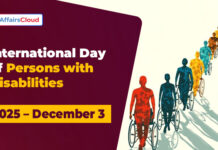 The United Nations (UN)’s International Asteroid Day (IAD) is a global awareness campaign, annually observed across the globe on 30 June, to raise public awareness about asteroid impact hazards and inform the public about the worldwide crisis communication actions for credible Near-Earth Object (NEO) threats.
The United Nations (UN)’s International Asteroid Day (IAD) is a global awareness campaign, annually observed across the globe on 30 June, to raise public awareness about asteroid impact hazards and inform the public about the worldwide crisis communication actions for credible Near-Earth Object (NEO) threats.
Background:
i.On 6 December 2016, the UN General Assembly (UNGA) adopted resolution A/RES/71/90, declaring June 30 as International Asteroid Day.
- The proposal for the IAD was made by the Association of Space Explorers (ASE), and endorsed by the Committee on the Peaceful Uses of Outer Space (COPUOS).
ii.The 1st ever IAD was observed on 30 June 2017.
Why June 30?
June 30th was chosen to commemorate the Tunguska impact event, which occurred in Siberia, the Russian Federation, in 1908. It is considered Earth’s largest recorded asteroid impact.
- The estimated size of the asteroid that exploded over the Tunguska region is 70 meters (m) and the asteroid explosion flattened across 830 square miles of forest.
Co-founders:
i.Asteroid Day, sanctioned by the UN was co-founded in 2014, by
- Dr. Brian May, an English Astrophysicist, a world-renowned guitarist, and a founding member of the rock group Queen;
- Russell L. (Rusty) Schweickart of America, the Lunar Module pilot on the Apollo 9 mission (the 1st to test the Moon-landing vehicle in space);
- Grig Richters, a German Filmmaker; and
- Danica Remy of America, President, and chief executive of B612 Foundation.
Near Earth Objects:
i.The NEO is an asteroid or comet that passes close to the Earth’s orbit and the NEOs represent potentially catastrophic threats to our planet.
ii.Asteroids, sometimes called minor planets, are rocky, airless remnants left over from the early formation of our solar system about 4.6 billion years ago.
Note: Out of more than 730,000 known asteroids, about 16,000 are NEO, and there are currently 1,784 potentially hazardous asteroids.
Global Response:
i.The United Nations Office for Outer Space Affairs (UNOOSA) addresses NEO impact hazards as a global issue.
ii.Addressing NEO hazards involves 2 main aspects:
- Identifying objects that pose a threat; and
- Planning mitigation campaigns.
ii.These require cooperative action from the international community to ensure public safety.
iii.Based on the recommendations for an international response to a NEO impact threat endorsed by the COPUOS in 2013, 2 key groups were formed in 2014:
- International Asteroid Warning Network (IAWN) assists in analysing impact consequences and planning mitigation responses.
- Space Mission Planning Advisory Group (SMPAG), an inter-space agency forum that identifies technologies for NEO deflection and builds consensus on planetary defence measures.
The Chelyabinsk Event:
i.On 15 February 2013, a superbolide (a large fireball) traveling at a velocity of 18.6 kilometers (km) per second, entered the atmosphere and disintegrated in the skies over Chelyabinsk.
ii.NASA estimated the asteroid’s diameter at 18 m and mass at 11,000 tons.
iii.The total impact energy was approximately 440 kilotons (kt) of Trinitrotoluene (TNT) explosives.
iv.The Chelyabinsk event was an extraordinarily large fireball, the most energetic impact event since the 1908 Tunguska blast.
About the United Nations Office for Outer Space Affairs (UNOOSA):
The UNOOSA established in 1958, promotes international cooperation in the peaceful use and exploration of space and the utilisation of space science and technology for sustainable economic and social development.
Director– Aarti Holla-Maini
Headquarters– Vienna, Austria




